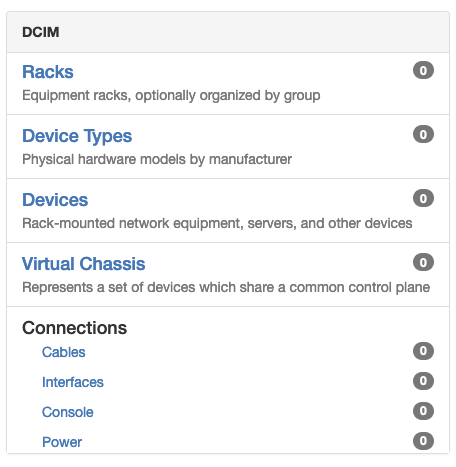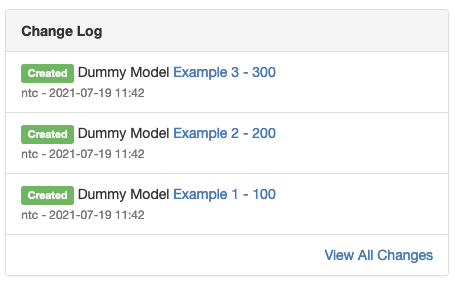Populating the Home Page¶
Added in version 1.2.0
Both core applications and plugins can contribute items to the Nautobot home page by defining layout inside of their app's homepage.py. Using a key and weight system, a developer can integrate amongst existing home page panels or can create entirely new panels as desired.
Adding a new Home Page Panel¶
Each panel on the home page is defined by a HomePagePanel object. A HomePagePanel may contain either or both of HomePageItem and/or HomePageGroup objects, or may define custom content via a referenced Django template. A HomePageGroup may itself contain HomePageItem objects as well, and individual HomePageItem objects may also reference custom Django templates.
Some examples:

This is a single HomePagePanel (defined in nautobot/dcim/homepage.py) containing four HomePageItem and one HomePageGroup (the Connections group, which in turn contains four more HomePageItem). Using these objects together allows you to create panels that match the visual style of most other panels on the Nautobot home page.

This is a HomePagePanel (defined in nautobot/extras/homepage.py) that uses a custom template to render content that doesn't fit into the HomePageGroup/HomePageItem pattern.
The position of a panel in the home page is defined by its weight. The lower the weight the closer to the start (top/left) of the home page the object will be. All core objects have weights in multiples of 100, meaning there is plenty of space around the objects for plugins to customize.
In the below code example, you can see that the Example Plugin panel has a weight value of 150. This means it will appear between Organization (weight 100) and DCIM (weight 200).
Tip
Weights for already existing items can be found in the Nautobot source code (in nautobot/<app>/homepage.py) or with a web session open to your Nautobot instance, you can inspect an element of the home page using the developer tools.
Example of custom code being used in a panel can be seen in the Custom Example Plugin panel below. The attribute custom_template is used to refer to the filename of a template. Templates need to be stored in the templates inc folder for the plugin (/example_plugin/templates/example_plugin/inc/).
If additional data is needed to render the custom template, callback functions can be used to collect this data. In the below example, the Custom Example Plugin panel is using the callback get_example_data() to dynamically populate the key example_data into the rendering context of this panel.
from nautobot.core.apps import HomePageItem, HomePagePanel
from .models import ExampleModel
def get_example_data(request):
return ExampleModel.objects.all()
layout = (
HomePagePanel(
name="Example Plugin",
weight=150,
items=(
HomePageItem(
name="Example Models",
link="plugins:example_plugin:examplemodel_list",
description="List example plugin models.",
permissions=["example_plugin.view_examplemodel"],
weight=100,
),
),
),
HomePagePanel(
name="Custom Example Plugin",
custom_template="panel_example_example.html",
custom_data={"example_data": get_example_data},
permissions=["example_plugin.view_examplemodel"],
weight=350,
),
)